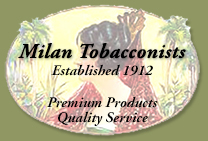
| |
 |

|
Frequently Asked QuestionsWelcome to Milan Tobacconists' FAQ page. If you aren't able to find the answer to your question here, please give us a call at 877.70MILAN or send your question to us by email - customercare@milantobacco.com. We'll do our best to answer it!
ABOUT SHOPPING
ABOUT CIGARS
ABOUT PIPES
How do I set up a new account? How do I obtain my password to order over the
Internet? What are your shipping charges? Orders are shipped via UPS or United States Postal Service (USPS), and the rates are automatically calculated based on the weight of your order and the chosen method of shipping at the point of check-out. We also offer free shipping, but some restrictions do apply -> click here to learn more about our free shipping offer. The following shipping methods are available to our customers: Via UPS Inside the United States
How long will it take for me to
get my order? When your order has been shipped, you will receive an email shipping
confirmation containing a tracking number or delivery confirmation number. Depending on your location within
the United States and the day and time the order is placed:
Do you ship to destinations outside the United
States and its Territories? Does Milan Tobacconists have a return policy?
We also will accept returns on merchandise damaged during shipping. Save both the original shipping carton and packing material and contact us for a return authorization number. We will either issue a refund or send a replacement for the damaged item. In all cases, the return authorization number should be clearly marked on the package next to the address label. We are not responsible for merchandise returned without a return authorization number, and the package may be refused. If you wish to exchange an item, please note that customers are responsible for all return shipping charges and new shipping charges, including tax if applicable. Please allow 5 business days after our receipt for your exchange to be processed and shipped to you. Special Orders: Special order items (items that we do not sell in our store or online) will be charged a 15% restocking fee.
What is the white substance I occasionally find
on my cigars? What difference does the origin of tobacco leaf
and wrapper make? Brazilian tobaccos have a dark, pungent and peppery, yet slightly sweet flavor profile. The leaf is black in color, once the fermentation is done. The San Andres Valley of Mexico is world-renowned for its sun-grown variety of Sumatra-seed tobacco used for wrappers, especially Maduro wrappers. Dark, peppery and slightly sweet tobaccos are also grown and utilized as long fillers and binders because of the excellent burning qualities. The Central African Republic and the West African Republic of Cameroon grow a distinctly unique tobacco used primarily for wrappers because of the dark, oily texture of the leaf and its neutral flavor tones. The leaf originated from Sumatra seeds imported from Indonesia. Nicaragua also produces high-quality Connecticut-seed and Cuban-seed tobaccos with rich and peppery, full-bodied flavors and heady aromas, reminiscent of the finest Cuban tobaccos. The tobacco strain grown in the Philippines is very aromatic, but light and mild in terms of strength. The U.S. Connecticut Valley produces the world's finest wrapper tobacco, "Connecticut Shade," noted for its smooth, light texture and elasticity. Connecticut broadleaf tobacco is also grown here. Its darker, heavy-veined leaf is used primarily on Maduro cigars. Both tobaccos create a mild to medium-bodied smoke with a mellow, nutty flavor. Cuban filler tobaccos have long been renowned for their robust, spicy, and pungently aromatic flavors. In addition, extremely tasty and supple wrapper leaves are grown here. There has been some debate in recent years over the consistency and quality of Cuban cigars, but overall they are still acknowledged by many to be the world's finest. After harvesting, the leaves are separated into bundles according to size and texture and hung to dry in curing barns for six to eight weeks. The curing process and the subsequent fermentation of the tobacco is necessary to release ammonia from the tobacco and reduces the overall nicotine content. The fermented tobacco is then allowed to age anywhere from 18 months to two years to enhance the taste and burning qualities of the tobacco. Poorly fermented cigars are harsh and bitter and burn unevenly. Master blenders combine tobaccos from different countries or different regions of the same country to achieve a distinctive and balanced smoke. Depending upon its ring gauge, a cigar will contain a blend of between two and five different tobaccos. At this point the torcedor, or cigar roller, is given the tobaccos to be used and the formula for their combination. The torcedor takes the filler leaves, compresses them, then places them on a binder leaf used to hold the filler together. Then they are rolled into a "bunch" and cut to the appropriate length before being placed into a wooden mold for further compression. After this step, the torcedor removes the bunch and wraps it with a supple, elastic wrapper leaf that has been cut in half. With much acquired skill, the torcedor rolls the wrapper around the bunch using constant pressure and applies a vegetable glue to bond the wrapper at the head of the cigar to prevent it from unraveling. At this point, cigars are allowed to age again so that the different tobaccos' flavor profiles can "marry" before being graded and boxed for sale. This process can last as little as 21 days and up to 180 days, perhaps even longer. The size and diameter of a cigar greatly influences the strength and burning qualities of the cigar. To put it very simply, cigars made with the same filler, binders, and wrapper, but of different sizes (in length and diameter) will each exhibit totally different flavor and strength profiles. Typically, larger cigars will be richer in flavor because of the increased amount of tobacco they contain, but they will have a cooler smoke and smoother taste than a smaller version of the same blend. They will burn slower and the smoke will cool down somewhat as it travels the length of the cigar as it is puffed. What shapes and sizes do cigars come in? Parejos:
Figurados:
It has been mistakenly perceived that the wrapper color indicates the cigar's strength. This in itself is incorrect, but due to either the strain of tobacco grown and/ or the curing process used, the wrapper can deliver a distinctive and unique taste to the taste buds as the cigar is smoked. At one time, the Cuban cigar companies used over two hundred names to describe the brown shades of color found in cured tobacco leaves. For brevity, we have used the following color scale to describe our cigars. Claro- A light tan color resulting from cutting the leaf before it has fully matured, then quickly air-drying it. Colorado Claro - A light medium brown color found on leaves from the top of the plant, which thus get more sun, and are allowed to mature longer both on the plant and after cutting. Also referred to as "natural" or "English Market Selection" (EMS). Colorado - A deep brownish/red color resulting from a lengthy maturation period. Usually has a light oily sheen. Colorado Maduro - A dark brown color found on leaves from the top of the tobacco plant that are allowed a much longer maturation period. Maduro - a very dark brown or black due to either longer exposure to the sun, a cooking process, or a longer period of fermentation. Maduro means "ripe " in Spanish. When purchasing a humidor, look for a box that has perfectly squared and fitted seams, a tight seal, and a Spanish cedar interior. Spanish cedar is the best wood used for lining a humidor for three reasons: tobacco beetles don't like it, it's unique in that it helps age cigars, and it is very good at retaining humidity. The cedar should be well aged, aromatic, and unfinished. When you close the box you should hear a quiet suction sound. If it clunks it isn't airtight and won't be able to maintain a constant level of humidity. Maintenance of the cigars in a humidor is very simple. Use a humidifier. Humidifiers are available in many shapes and sizes. Most of them are made of "Oasis," the same material you find in floral arrangements. Oasis holds a lot of humidity. Be sure to buy a humidifier that is big enough for all the cigars in your humidor. Another product you may wish to have is a hygrometer, which measures relative humidity. Digital hygrometers are the most accurate. Otherwise, the condition of the cigars is the perfect measure of your humidor's performance. If the cigars exhibit a slightly oily sheen and when gently squeezing the foot of the cigar with your fingers it springs back like a loaf of fresh bread then conditions are ideal. If they seem dry then add more distilled water. Also be sure to keep your humidor away from windows, heating/air vents, and other heat sources to prevent warping or other undue stress. Check your cigars every day until you break in your humidor. Eventually, you'll get to know your humidor and how often to refill your humidification device (always use distilled water). Even then, it's a good idea to check it every day. Also, a good idea would be to leave the box open for about 15 minutes a couple times a week to let some air circulate through the cigars, which will keep them from getting too moist or moldy. Another tip is to rotate the bottom row of cigars to the top every so often to make sure all of your cigars are humidified evenly. To break in a new humidor, pour distilled water in your humidifier to activate it. Wipe down the interior of your humidor with a clean, slightly damp cloth. Again, use distilled water. Put shot glasses or several small cups of distilled water inside the humidor and then let it sit for 24 to 48 hours. Remove the cups of water and add your cigars, being sure to check them every day. A cigar storage alternative to a humidor is a food storage container, such as Tupperware. Place an appropriately sized humidification device in the container, remembering not to let the device actually touch your cigars. Tobacco does need to breathe in order to age properly. That's why wooden humidors are not hermetically sealed. You should open your container every few days (once a week at least) for about 15 to 20 minutes. It is even better if you can get some pieces of cedar to put in there with your cigars.
How do you recommend I light my cigar? Is there a "proper" way to smoke my cigar? What do I do with my cigar when I'm finished?
Does the quality of the pipe and/or the tobacco
really make a difference? What is the best way to pack a pipe?
How do I keep my pipe lit? When should I clean my pipe and how?
|
|
Premium Cigar Association Formerly IPCPR 
|
This GeoTrust
Certified secure site accepts: |
and Member of Cigar Rights of America's National Tobacconist Program 
|
|
Milan Tobacconists, Inc. •
309 South Jefferson Street, Roanoke, VA 24011 • Toll
Free 877-70MILAN (64526) • customercare@milantobacco.com Join Milan Tobacconists on Facebook, X - Formerly Twitter, Instagram, YouTube, and Pinterest for Real-Time IMPORTANT NOTICE: Milan
Tobacconists does not sell cigarettes on this site, nor do we sell tobacco
or related products to anyone under the age of 21. By entering this site,
you certify that you are at least 21 years old and consent to an age and
identity verification to validate that fact. Misrepresentation of your
age and identity may be punishable by law. |
||